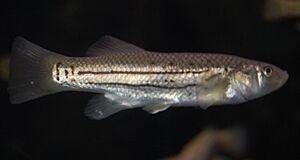Striped killifish facts for kids
Quick facts for kids Striped killifish |
|
|---|---|
 |
|
 |
|
| Male above, female below. At the New England Aquarium |
|
| Conservation status | |
| Scientific classification | |
| Synonyms | |
|
The striped killifish (Fundulus majalis) is a cool fish found in North America. It's also sometimes called the striped mummichog. These fish live in salty ocean water and slightly salty "brackish" water. You can find them in shallow areas along the coast, all the way from New Hampshire down to Florida. They also live in the northern part of the Gulf of Mexico.
Striped killifish are special because the males and females look different. This is called sexual dimorphism. Males have black stripes that go up and down their bodies. Females have black stripes that go sideways, along their silver-colored bodies. Young female fish have vertical stripes, but as they grow, these change to horizontal ones. Even adult females keep one or two vertical stripes near their tail. These fish usually grow to be about 6 inches (15 cm) long. Sometimes, they can even reach 7 inches (18 cm)!
Amazing Survival Skills
In 1916, a science magazine called Popular Science Monthly wrote about some interesting research. Professor S. O. Mast, a scientist from Johns Hopkins University, was studying the striped killifish. He noticed their amazing ability to survive when ocean tide pools dried up.
These fish would swim in and out of the tide pools at regular times. It seemed like they knew when to swim out before the water drained away. But what if the pool's exit got blocked as the tide went out? The fish would quickly swim around, looking for another way to escape.
Walking on Land
If a striped killifish can't find a way out, it does something incredible. It actually leaves the water and flops across the land to reach the ocean! Professor Mast saw many of these fish leave large tide pools. They would travel across sand bars that were up to 12 feet (3.7 meters) wide and 6 inches (15 cm) tall.
The fish almost always leave the pool on the side closest to the ocean. They are able to travel straight towards the ocean instead of flopping around randomly. At the time, scientists didn't know how the fish could find the ocean so easily.
Escaping a Trapped Pool
After about three minutes of being stuck in a shrinking tide pool, a large group of fish forms. They gather on the side of the pool that faces the ocean. Then, they swim up and down that side of the pool. After that, they leave the pool in groups of about twelve. They head across the land towards the sea, ready for their next adventure!



